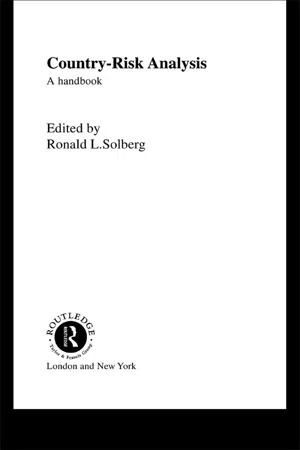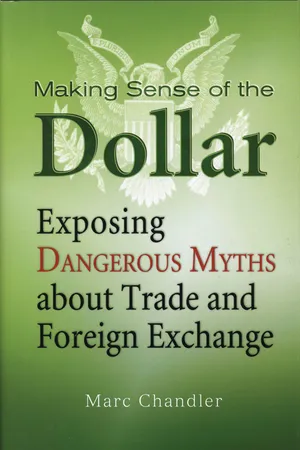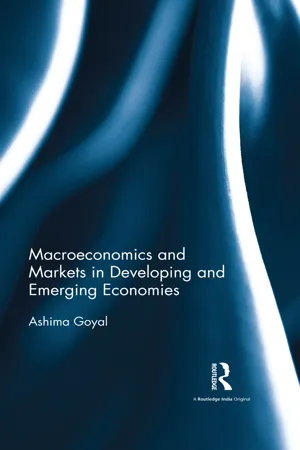Current Account Surplus
A current account surplus occurs when a country's total exports of goods, services, and transfers exceed its total imports. This results in a positive balance of trade and indicates that the country is a net lender to the rest of the world. A current account surplus can lead to an appreciation of the country's currency and may also indicate strong domestic savings.
6 Key excerpts on "Current Account Surplus"
- eBook - ePub
Contemporary Economics
An Applications Approach
- Robert Carbaugh(Author)
- 2016(Publication Date)
- Routledge(Publisher)
...The capital and financial account balance is a deficit if those in the United States buy more assets from foreigners than they sell to foreigners. What Does a Current Account Deficit (Surplus) Mean? The current account and the capital and financial account are not unrelated; they are essentially reflections of one another. Recall that each international transaction represents an exchange of goods, services, or assets among households, businesses, or governments. Thus, the two sides of the exchange must always balance. This means that, sign ignored, the current account balance equals the capital and financial account balance, as shown in the following equation: Current account balance=Capital and financial account balance It follows that any current account deficit must be balanced by a capital and financial account surplus. Conversely, any Current Account Surplus must be balanced by a capital and financial account deficit. To better understand this notion, assume that in a particular year your spending is greater than your income. How will you finance your deficit? By borrowing or by selling some of your assets. You might liquidate some real assets (for example, sell your personal computer) or perhaps some financial assets (sell a U.S. government security that you own). In like manner, when a nation experiences a current account deficit, its expenditures for foreign goods and services are greater than the income that it receives from the international sales of its own goods and services, after making allowances for investment income flows and gifts to and from foreigners. The nation must somehow finance its current account deficit. But how? By borrowing or by selling assets. In other words, a nation’s current account deficit is financed essentially by a net inflow of capital in its capital and financial account...
- eBook - ePub
- Anthony J. Makin(Author)
- 2016(Publication Date)
- Routledge(Publisher)
...More recently, Singapore had current account deficits reaching over 20 per cent of GDP in the early 1970s. Discussion of the behaviour of an economy’s external accounts often centres on current account balances, and ignores the matching capital account balances, which can allow real investment and hence national output growth to be higher than otherwise. Similarly, a focus on the rise in external liabilities, reflecting a higher degree of economic integration with the rest of the world, can enable higher investment and hence higher national wealth. In open economies, large external imbalances are acceptable on the grounds that the distribution of international investment opportunities does not necessarily coincide with the distribution of world saving. This is provided the financial systems that channel international saving are sound and that they closely monitor borrowing and lending risks. One popular concern about growth in the size of an economy’s current account deficit is that it is symptomatic of the economy ‘living beyond its means’. Relatedly, rising international indebtedness associated with persistent current account deficits may be judged unacceptably high. The ‘living beyond its means’ idea can be explained with reference to the national accounting identity, Y = C + I + G + (X - M) When rearranged, this relationship yields the ‘absorption’ equation derived earlier in Chapter 2. That is, X - M = Y - (C + I + G) which shows that the trade imbalance for a given period equals the difference between national expenditure and national income. To finance the extra spending, an increase in the level of external liabilities has to be recorded in the foreign investment statistics. It is therefore true by definition that a current account deficit shows an excess of spending over income per period...
- P. Arestis, Kenneth A. Loparo, P. Arestis, Malcolm Sawyer(Authors)
- 2013(Publication Date)
- Palgrave Macmillan(Publisher)
...The first problem is related to the fact that a current account imbalance involves the existence of net financial flows. Consequently, the higher the size of the current account imbalance, the higher the size on the net financial flow will be. The corresponding financial flows can be a source of potential problems for the economy involved, affecting the domestic interest rate, the exchange rates (for instance, leading to exchange rates departing from the fundamental real exchange rate that balances the balance of payment), 2 the accumulation of foreign reserves, affecting the capacity of monetary policy to fulfil domestic objectives, and so on. Starting from the usual Keynesian income equation, where (Savings – Investment) + (Tax revenue – Government expenditure) = Current account deficit, if the private sector is balanced (private investment being equal to private savings), an imbalance in the current account comes necessarily with a fiscal imbalance: countries with surpluses (deficits) in the current account have surpluses (deficits) in their public finances. In the specific case of deficit countries, these economies have twin deficits. This raises the possibility for these economies to suffer twin crises (balance of payments and fiscal crisis), a situation that can be even worse in these problems moves to the banking-financial domestic sector. Third, if current account imbalances are permanent, they can also generate further problems. Assuming that the exchange rate remains unchanged, countries with permanent surpluses in the current account will accumulate foreign reserves. This accumulation can lead to losses in the welfare of the domestic agents and, also, to problems in the management of the domestic policy, reducing its effectiveness as a tool of macroeconomic policy to correct domestic problems. In countries have deficits in the current account, they will have to finance that deficit with a net capital inflow, increasing their external debt...
- eBook - ePub
Country Risk Analysis
A Handbook
- Ronald L. Solberg(Author)
- 2002(Publication Date)
- Routledge(Publisher)
...3 Current-account forecasting Milan N.Brahmbhatt INTRODUCTION A country’s balance-of-payments statement records its economic transactions with the rest of the world, including trade in goods and services, certain unilateral transfers between countries, and changes in claims on and liabilities to the rest of the world. Goods, services and transfers are conventionally grouped under the current account of the balance of payments, while changes in a country’s international asset and liability position are grouped under the capital account. Economic models of the balance of payments also observe this distinction because flows on the two accounts are thought to be determined by different forces. Flows of goods and most kinds of services on the current account are generally held to be determined by income and relative prices, and are thus modeled in a supply-and-demand framework similar to that used for individual commodities. Flows in the capital account, viewed in a portfolio-balance framework, are, on the other hand, thought to be determined by factors such as the total wealth of individuals and relative rates of return on assets. The conventions of double-entry bookkeeping ensure that a current-account deficit, for example, is exactly matched by a capital-account surplus (or inflow), defining the capital account to include all types of long- and short-term capital flows as well as changes in the official settlements balance. How this equality comes about in practice will depend on the nature of the economic regime in force. In a fixed-exchange-rate regime the part of a current-account deficit not financed by other capital inflows will be covered by a change in the official settlements balance; that is, by a reduction in official foreign reserves or by official short-term overseas borrowing...
- eBook - ePub
Making Sense of the Dollar
Exposing Dangerous Myths about Trade and Foreign Exchange
- Marc Chandler(Author)
- 2010(Publication Date)
- Bloomberg Press(Publisher)
...In modern times, it has been “the indispensable country” as Madeleine Albright once awkwardly called it. But this is not reflected in the current account position or in the movement of the U.S. dollar. The current account deficit is not a measure of America’s economic strength because it shows, in part, that the nation is rich and large enough to promote global growth by absorbing other countries surplus goods and savings. The evolutionary expansion strategy of American companies encourages international development by setting up operations in other countries, preferring to import profits rather than export goods (though it is still among the leading exporters). To be sure, this is not an argument of American exceptionalism. It is partly a function of scale. The 2007 gross domestic product of $13.8 trillion was the largest in the world; the second-largest economy, Japan, had a GDP of just $4.4 trillion. 17 Its sheer size means that America can incorporate trade within its foreign economic strategy in very different ways from the rest of the world, making its economy even richer—and the world better off. The argument is that international growth and development is not necessarily the zero-sum game that the focus on the current account suggests. Of course, the role of capital markets in trade and exchange rates throws politicians for a loop. “We have better capital markets!” doesn’t generate national pride the same way that slogans like “We make the best cars!” or “We have the most productive people!” do. But it’s reality in the modern world. The current account doesn’t show America’s strength, and it does not predict the price of the dollar...
- Ashima Goyal(Author)
- 2016(Publication Date)
- Routledge India(Publisher)
...Although ceteris paribus, a rise in government spending in excess of revenue (the fiscal deficit), would increase the current account deficit, a fiscal deficit need not imply a current account deficit if household savings are large. Aspects of dualism can imply that even twin deficits need not create aggregate excess demand. The concepts were illustrated with the Indian experience. An integral aspect of intertemporal optimisation is forward-looking behaviour. The future, therefore, affects the present. This is especially the case with assets. Currency becomes an asset, whose value is subject to substantial variations, under a floating exchange rate and a more open capital account. We turn to the asset approach to the exchange rate in the next chapter. Notes 1 GDP minus depreciation and taxes plus transfers is the income households receive. Secondary incomes, such as gifts and transfers from abroad, are part of a country’s income but not of its GDP. 2 The earlier classification puts transactions that affected nations’ balance sheets in the current account, which should be a record of current transfers from nations’ income. For example, an international asset transfer, such as debt forgiveness, would have earlier entered the current account but was now put in the capital account. 3 The debate on global current account imbalances occurred in the 2000s, since China ran a large Current Account Surplus and the United States a large deficit. The intertemporal approach suggests that just exchange rate adjustments are not adequate to correct imbalances. Deeper changes are required that would reduce high Chinese savings and increase low US savings. 4 This theory was first worked out, in the context of the large CA deficits that some nations ran in order to smooth consumption, after the oil shocks. See Blanchard and Fisher (Chapter 2) for a formal derivation of consumption smoothing in an open economy...





